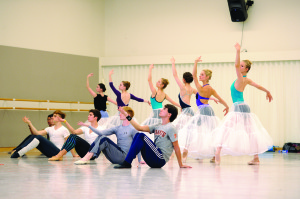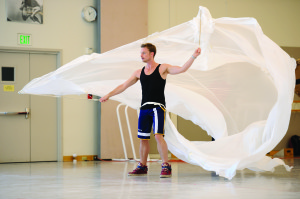If only ballet had a fairy godmother. With a wave of her magic wand, she could summon bewigged coachmen to deliver the buckets of money required to produce spectacular new story ballets. Alas, no such godmother is forthcoming.
To make up for her absence, ballet companies are teaming up to share the costs of producing original works. For a financial investment of roughly two-thirds the cost of a solo production, both companies get a premiere, custom costumes, sets adaptable to their theater space, expanded creative connections, and the higher profile that comes with trying something new.
At the frontier is San Francisco Ballet, which presents its first full co-production with Cinderella, which receives its U.S. debut Friday, May 3. (SFB’s 2011 Coppélia was a shared production in certain ways, but it was not made from scratch.) Created in partnership with the Dutch National Ballet and choreographed by Christopher Wheeldon, Cinderella had its world premiere in Amsterdam last December.

Evocative of the grim Grimm story rather than the sanitized Disney version, this Cinderella has sets and costumes designed by Broadway and Met Opera vet Julian Crouch, puppets by Obie Award–winning puppeteer Basil Twist, snarky stepsisters, a mystical tree, video projections and Prokofiev’s beloved original score. In her review of the world premiere in London’s Financial Times, critic Laura Cappelle said it “may well be the most dramatically convincing Cinderella in ballet” and described it as “a triumph of storytelling and stage design firmly in touch with the 21st century.”
Wheeldon was actually the catalyst for the co-production. “We had spoken with Christopher about producing a full-length ballet for us, and it hadn’t panned out,” said SFB artistic director Helgi Tomasson. “He ended up calling us when he began working with Dutch National on Cinderella, because the company needed a partner.” What began as a Dutch production became a joint effort, with Wheeldon creating different parts of the choreography on each company’s dancers, then traveling between Amsterdam and San Francisco to set the sections on the others.
A highly experienced choreographer like Wheeldon, who was already familiar with both companies, can integrate the dancers’ differences in the work he creates. The logistical side of the equation—sets, costumes and technical aspects—entails its own complications, according to SFB technical director Chris Dennis, who traveled to Amsterdam to see the performance and plan its transition to San Francisco. The Amsterdam Music Theatre has a larger stage and proscenium than War Memorial Opera House, so Dennis kept a close eye on every minute detail during the design process (and triple-checked the metric–U.S. conversions).
“[Julian] Crouch would lay the plans for the two theaters on top of one another so he could see how things fit between the venues, and both companies were given the drawings,” Dennis said. “We’re finding that when we transfer the show from Amsterdam to SF, there are some areas that there’s not enough clearance. So if two pieces of scenery are hanging 8 inches apart, there’s more room for the two pieces to pass by one another; if they’re 6 inches apart, there’s a little less room.” Too much rearrangement of scenery, set decoration, and props would require changes to the choreography, so Dennis and his team ensure that “by the time the dancers get on stage, technically, everything that was marked out in the studio is in the same relationship.”

There are countless challenges in co-producing a work, Tomasson said, from scheduling and shipping (in this case, overseas) to costuming. For Cinderella, the measurements of every participating dancer in both companies were taken, and costumers created garments in as many shareable sizes as possible, with the usual extra fabric allowed for tailoring; additional versions were made for very petite and very tall dancers. Cinderella was also created with an eye to touring; DNB holds the European performance rights, and SFB holds the North American ones, and the entire production will be shipped hither and yon as they travel. “If the work is popular and performed often in a company’s repertory, you have to consider wear and tear on the production, too. There’s quite a lot to think about,” Tomasson said.
Lest it all seem like wicked drudgery, the process was leavened by artistic wonder. One day, Dennis recalled, “Basil said, ‘I want some cardboard, I want some tape, I want some paper, I need scissors, box cutters, wire.’ With all that stuff he created props for Cinderella’s carriage. All that information was sent to Amsterdam, and then they built exactly what he created from the cardboard. That was a really interesting process, seeing the final product of what started on one continent and ended on another continent.” So perhaps there was a little magic involved, after all.
Cinderella runs Friday, May 3 through Sunday, May 12, at the War Memorial Opera House, 301 Van Ness Ave, SF. Tickets $36–350. 415-865-2000 or SFBallet.org.
This article appeared in the May 2013 issue of In Dance.

